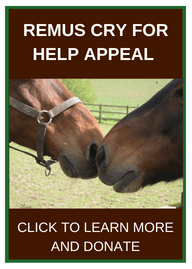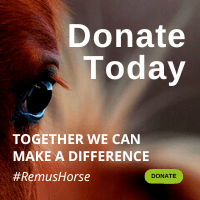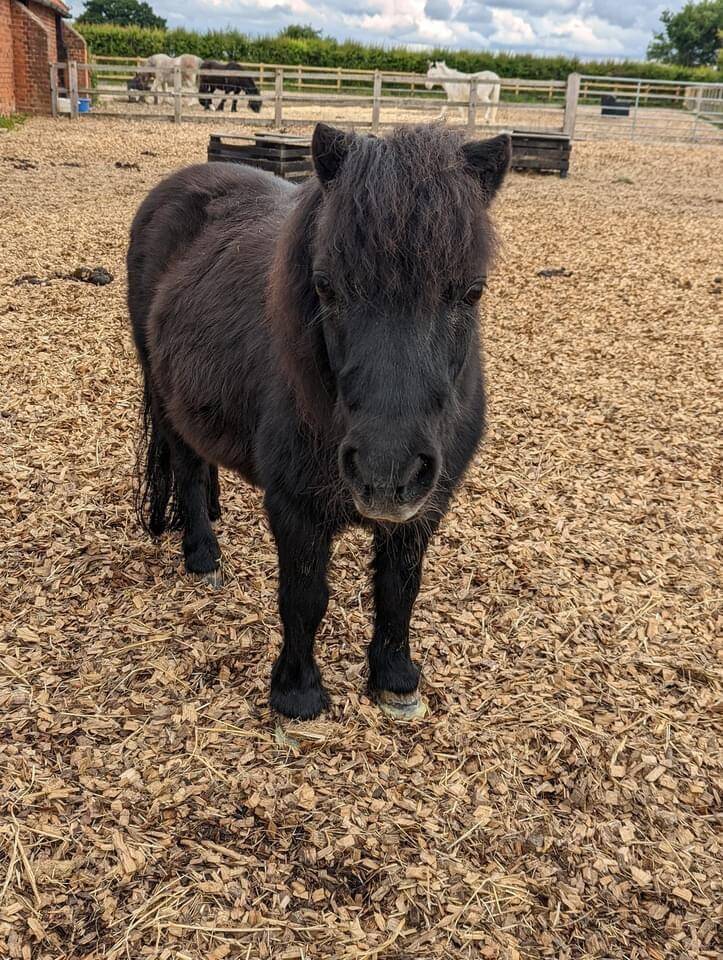
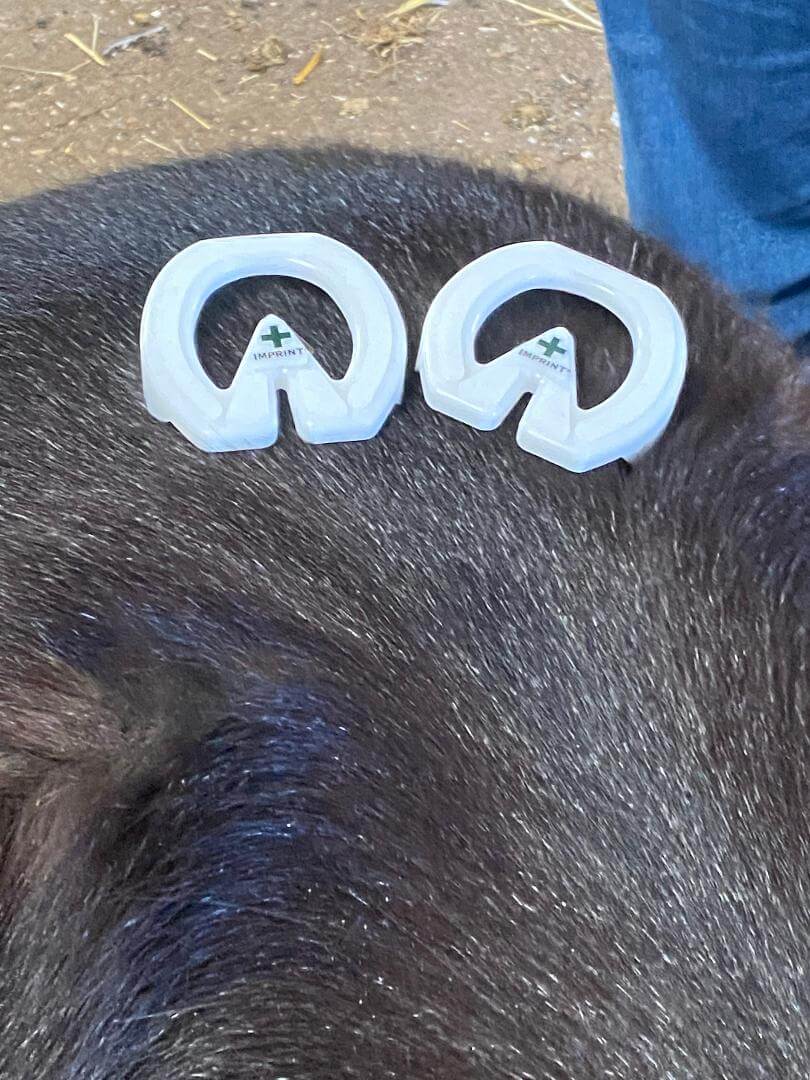
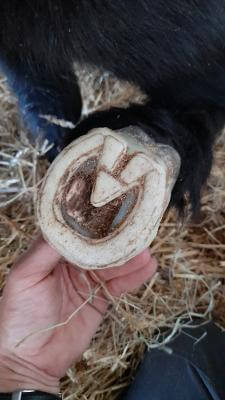
Little Ted’s New Shoes
Little Ted, one of our Shetland ponies, has been struggling a lot this spring with laminitis and has been extremely sore.
Working with our Vet and Farrier we agreed to try plastic glue-on shoes on him as they have helped some of our other horses. Ted is tiny so the shoes are very small, but they have made a huge difference. Of course, like everything now, they are very expensive to have fitted, but they have given him back a quality of life and given us back our happy old fella! You can see the little shoes shown resting on his back before being fitted.
With the increased nutrition, especially sugar that the spring and summer grass brings, it causes a condition called laminitis.
Laminitis is inflammation of the laminae of the foot – the soft tissue structures that attach the pedal (pee-dal) bone of the foot to the hoof wall. The inflammation and damage to the laminae causes extreme pain and leads to instability of the pedal bone in the hoof. In more severe cases it can lead to complete separation of and rotation of the pedal bone within the hoof wall which can penetrate through the bottom of the sole. This then becomes life threatening and often results in the horse being put to sleep.
To treat this, we remove the horse from the grassy paddock or field it is on and move it to a balder paddock or woodchip area or stabled facility. Grass is then completely avoided; hay is given in its place on a strict dietary amount. Pain relief is given as required and sometimes remedial farrier work is done. The horse or pony is closely monitored over the next few weeks for signs of improvement and to ensure it’s coping with this new management structure accordingly.
The vet will be contacted and will visit if necessary. Once an animal has a laminal episode they are then prone to it for life which is why we need more woodchip paddocks so that we can provide more laminitic horses with an outside environment where they don’t have access to grass but can still be outside with their friends and see what’s going on, rather than being stuck in a stable.
Over 90% of all episodes of laminitis are brought on by endocrine disease so either Pituitary Pars Intermedia Dysfunction (PPID, previously known as Equine Cushing’s Disease) which is a complex condition associated with abnormal function of a small, hormone-producing organ, the pituitary gland, that lies at the base of the brain. Or Equine Metabolic Syndrome which is a hormonal disorder quite similar to Type 2 diabetes in humans. Laminitis and its associated issues are responsible for approximately 7% of all equine deaths.
You can see further images of Little Ted supporting some very fetching glue-on shoes which reduce the concussion on his feet whilst walking to help support his laminitis.
If you’d like to make a donation towards a new laminitic paddock, please do so here.
The Problems with Grass Grazing
We are now into winter after a very good summer for grass growth. That means it’s time to put some of the horses and ponies back to their original fields after being kept in on limited grazing for the last 6 months.
This is always a very exciting affair for both us and them to enjoy. Being cooped up this long is unusual given the good weather we have enjoyed this year – good for the grass to grow at least. It was wet and warm for long periods, which is ideal for the fields.
Unfortunately for a lot of our individuals, this flush of grass brings about laminitis, a serious health concern which can ultimately, if left unmanaged, lead to severe pain and even death
Laminitis is defined as ‘Inflammation of the laminae of the hooves causing lameness, often severe’. This inflammation is caused by the increased sugar levels in the grass which some individuals’ bodies can’t deal with. It therefore becomes damaging in the bloodstream, especially around the pedal bone in the foot, which in severe cases can rotate and penetrate downwards through the hoof at the bottom.
To avoid these problems during the spring months when the grass becomes very lush and high in sugar, we take all of our problem horses off these pastures and move them to areas of poor grass growth or bare paddocks that are coated with woodchip. We then carefully control their diet with hay to supplement the grazing they are losing and monitor them closely over the next few months.
Find out more about laminitis and visit our website for some winter advice for you and your animals when coping with snow, frost and ice.
If you’re able to help with a donation for our running costs during these difficult winter months, please visit: www.remussanctuary.org/donate
Laminitis: the silent monster in older horses
We’re finally enjoying some much warmer weather but, as usual for horse owners, it comes with additional challenges! Many vets up and down the country have reported rises in cases of Laminitis, with the mixture of the warm and wet weather making the grass grow like crazy.
Many of our residents here at Remus are elderly and Laminitis is just one of the conditions that we are very careful to monitor all year round. While late teens used to be considered old for a horse, many now live and often work well into their twenties and longer.
And now, a new study has found that horses over the age of 25 may be suffering from chronic Laminitis but not showing any of the obvious signs.
The research has come out of the Swiss Institute of Equine Medicine. They looked at 51 clinically sound horses between the ages of 15 and 32, so what we would consider ‘veterans’.
They x-rayed their feet to check for pedal bone rotation and also assessed their body condition scores (BCS), cresty neck scores (CNS) and levels of adrenocorticotropic hormone (ATCH), which can be a sign of Cushing’s, another condition often found in older horses that can lead to Laminitis.
Almost half of the horses’ x-rays showed signs of pedal bone rotation, but none showed signs of acute lameness or Cushing’s, which goes to show that our horses could be suffering in ways we don’t expect so monitoring and awareness are key.
Read more about this in Horse & Hound.
You might also like to take a look at our feature in Horse Magazine on how we eradicated Laminitis from the Sanctuary.
You can also visit our website to learn more about elderly horse care.
Spring has sprung: how have your horses done?
The daffodils are out and the sun is making more appearances – yes, spring is well and truly on its way!
It’s been a long, hard winter for everyone, but how are your horses doing? From a welfare point of view there are a few things we need to be on top of as we head into spring. The main one is weight. Horses are designed to lose some weight over winter in preparation for the lush spring grass.
If your horse is a good doer, winter is an ideal opportunity for him to lose some pounds. The dreaded laminitis is a real threat at this time of year so, if he hasn’t lost a little, consider slowly introducing more exercise and decreasing his hard feed. If your horse is retired or not ridden, like our residents here at Remus, then some walking in hand could be beneficial. For more information about laminitis, you can also read our previous blog on the subject here: Laminitis Alert for Horse Owners and/or download this article from Horse Magazine which featured our research work.
If your horse has lost too much weight over winter then good nutrition and appropriate rugging until the weather warms up will help. The spring grass will also give him some much needed nutrients, but if you’re at all worried then speak to your vet.
Check out the full vet health check from Your Horse magazine for more information: www.yourhorse.co.uk/advice/vet-advice/articles/vet-health-check-has-your-horse-wintered-well
And if you would like to contribute to our winter feed appeal to help the many neglected, malnourished and tethered horses out there, you can find out more and do so here.
Keep fit to reduce laminitis risk
An Australian study has shown that light exercise can help to reduce the risk of laminitis for horses and ponies. It’s a worry we all have at this time of year, but, while we can become obsessed with restricting grazing and getting out the weight tape every week, are we overlooking the need for simple exercise?
Busy holiday schedules and hotter summers can see our horses and ponies left out in the field and not ridden as often as we’d like. This study by the University of Melbourne has shown that even gentle exercise can make a real difference.
They studied two groups of horses; a diet-only group and an exercised-only group. High levels of insulin have been linked to laminitis and the diet-only group showed both lower insulin levels and weight loss at the end of the trial. The exercised-only group didn’t lose weight but had improved insulin sensitivity, which means they needed to produce less insulin to control blood sugar, therefore reducing their laminitis risk.
So keep an eye on your horse’s weight and get out for those evening hacks where you can. If your horse is retired or not ridden, like our residents here at Remus, then some walking in hand could be beneficial.
You can read more about the trial in this Horse & Hound article.
If you’re interested, you can also read our previous blog on the subject here: Laminitis Alert for Horse Owners and/or download this article from Horse Magazine which featured our research work.
Happy hacking!
The dreaded ‘L’ word
It’s a word that can strike fear in every horse owner – laminitis. We’ve enjoyed a lovely spring and early summer so far, but this seemingly constant threat to our horses’ and ponies’ health can be stressful. Many of us are in tune to the slightest niggle, off colour expression or uncharacteristic behaviour, but laminitis can manifest itself in many different ways, so it’s important that we arm ourselves with as much information and knowledge as possible!
We have experienced our fair share of laminitis cases here at Remus, but in the last few years we’ve successfully put steps in place to prevent and/or manage the condition for our residents. We have: big shavings paddocks as an alternative to them being at grass if required; a ‘no sugar’ policy on the yard; our own weighbridge to keep on top of their weight; and holistic care including aromatherapy, reiki and shiatsu to reduce stress (which can also be a trigger) and help our residents cope with any problems they have.
Every horse and pony’s needs will be different, but there are lots of resources online to help you out. This article from Horse & Rider is a great starting point: https://www.horseandrideruk.com/expert-advice/articles/laminitis-everything-need-know/ or why not refer to our own 4 page feature in Horse Magazine here.

